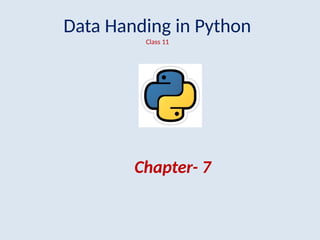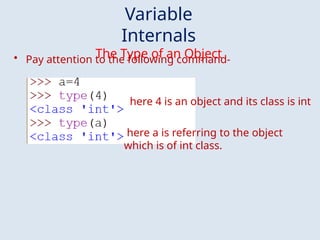Grade XI - Computer science Data Handling in Python
- 1. Data Handing in Python Class 11 Chapter- 7
- 2. Introduction • In this chapter we will learn data types, variables, operators and expression in detail. • Python has a predefined set of data types to handle the data in a program. • We can store any type of data in Python.
- 3. DATA TYPES • Data can be of any type like- character, integer, real, string. • Anything enclosed in “ “ is considered as string in Python. • Any whole value is an integer value. • Any value with fraction part is a real value. • True or False value specifies boolean value. • Python supports following core data types- I. Numbers II. String III. List IV. Tuple V. Dictionar y (int like10, 5) (float like 3.5, 302.24) (complex like 3+5i) (like “pankaj”, ‘pankaj’, ‘a’, “a” ) like [3,4,5,”pankaj”] its elements are Mutable. like(3,4,5,”pankaj”) its elements are immutable. like {‘a’:1, ‘e’:2, ‘I’:3, ‘o’:4, ‘u’:5} where a,e,i,o,u are keys and 1,2,3,4,5 are their values.
- 4. CORE DATA TYPES Graphical View CORE DATA TYPE Numbers Integer Boolean Floating Point Complex None Sequences String Tuple List Mappings Dictionary
- 5. Mutable and Immutable Types • In Python, Data Objects are categorized in two types- • Mutable (Changeable) • Immutable (Non-Changeable) Look at following statements carefully- p = 10 q = p they will represent 10, 10, 10 r = 10 Now, try to change the values- p = 17 did the values actually change? r = 7 q =9 Answer is NO. Because here values are objects and p, q, r are their reference name. To understand it, lets see the next slide.
- 6. Variables and Values An important fact to know is- – In Python, values are actually objects. – And their variable names are actually their reference names. Suppose we assign 10 to a variable A. A = 10 Here, value 10 is an object and A is its reference name. 10 Reference variable Object
- 7. Variables and Values If we assign 10 to a variable B, B will refer to same object. Here, we have two variables, but with same location. Now, if we change value of B like B=20 Then a new object will be created with a new location 20 and this object will be referenced by B. 10 10 20 Referenc e variable Object
- 8. Mutable and Immutable Types Following data types comes under mutable and immutable types- • Mutable (Changeable) – lists, dictionaries and sets. • Immutable (Non-Changeable) – integers, floats, Booleans, strings and tuples.
- 9. Variable Internals The Type of an Object • Pay attention to the following command- here 4 is an object and its class is int here a is referring to the object which is of int class.
- 10. Variable Internals The Value of an Object • Pay attention to the following command- here value output is coming via print() The ID of an Object • Pay attention to the following command- Here value 4 and variable a are showing same id which means 4 is an object being referenced by a that’s why they are keeping same id.
- 11. Operators • The symbols that shows a special behavior or action when applied to operands are called operators. For ex- + , - , > , < etc. • Python supports following operators- I. Arithmetic Operator II. Relation Operator III. Identity Operators IV. Logical Operators V. Bitwise Operators VI. Membership Operators
- 12. Arithmetic Operators • Python has following binary arithmetic operator - • For addition + • For subtraction – • For multiplication * • For division / • For quotient // • For remnant % • For exponent ** for ex- 2+3 will result in to 5 for ex- 2-3 will result in to -1 for ex- 2*3 will result in to 6 its result comes in fraction. for ex- 13/2 will result in to 6.5 its result comes as a whole number for ex- 13/2 will result into 6. its result comes as a whole remnant number.For ex-13/2will
- 13. Assignment Operators and shorthand • Python has following assignment operator and shorthand - • = a=10 , 10 will be assigned to a. • += a+=5 is equal to a=a+5. • -= a-=5 is equal to a=a-5. • *= a*=5 is equal to a=a*5. • /= a/=5 is equal to a=a/5. • //= a//=5 is equal to a=a//5. • %= a%=5 is equal to a=a%5. • **= a**=5 is equal to a=a**5.
- 14. Relational Operators • Python uses Relational operators to check for equality. These results into true or false. Relational Operator are of following types- • < Less Than like a<b • > Greater Than like a>b • <= Less Than and Equal to like a<=b • >= Greater Than and Equal to like a>=b • == Equal to like a==b • != not Equal to like a!=b
- 15. Identity Operators Identity operator is also used to check for equality. These expression also results into True or False. Identity Operators are of following types- • “is” operator • “is not” operator if a=5 and b=5 then a is b will come to True if a=5 and b=5 then a is not b will come to False • Relational Operator ( == ) and Identity operator (is) differs in case of strings that we will see later.
- 16. Logical Operators • Python has two binary logical operators - • or operator » if a = True and b = False then a or b will return True. • and operator » If a = True and b = False then a and b will return False. • Python has one Unary logical operator – • not operator • if a = True then not a will return False.
- 17. Operator Associativity • In Python, if an expression or statement consists of multiple or more than one operator then operator associativity will be followed from left-to- right. • In above given expression, first 7*8 will be calculated as 56, then 56 will be divided by 5 and will result into 11.2, then 11.2 again divided by 2 and will result into 5.0. *Only in case of **, associativity will be followed from right-to-left. Above given example will be calculated as 3**(3**2).
- 18. Expressions • Python has following types of expression - • Arithmetic Expressions like a+b, 5-4 etc. • Relational Expressions like a>b, a==b etc. • Logical Expressions like a>b and a>c , a or b etc. • String Expressions like “Pankaj” + “Kumar” etc.
- 19. Type Casting • As we know, in Python, an expression may be consists of mixed datatypes. In such cases, python changes data types of operands internally. This process of internal data type conversion is called implicit type conversion. • One other option is explicit type conversion which is like- <datatype> (identifier) For ex- a=“4” b=int(a) Another ex- If a=5 and b=10.5 then we can convert a to float. Like d=float(a) In python, following are the data conversion functions-
- 20. Working with math Module of Python • Python provides math module to work for all mathematical works. We need to write following statement in our program- import math output of this program will be 5.0 To get to know functions of a module, give following command- >>>dir (math)
- 21. Taking Input in Python • In Python, input () function is used to take input which takes input in the form of string. Then it will be type casted as per requirement. For ex- to calculate volume of a cylinder, program will be as- • Its output will be as-
- 22. DEBUGGING Debugging in Python is the process of identifying and resolving issues or errors in the code. It involves analyzing the code to find the root cause of unexpected behavior, exceptions, or incorrect output. The primary goal of debugging is to locate and fix bugs, ensuring that the code works as intended and produces the correct results.
- 23. Types of Built-in Exceptions Python's built-in exceptions cover a wide range of error conditions. Here are some of the common categories and specific exceptions: Arithmetic Errors: These include OverflowError, ZeroDivisionError, and FloatingPointError, which occur during arithmetic operations. Attribute Errors: AttributeError is raised when attribute reference or assignment fails. File Errors: FileNotFoundError is raised when a file or directory is requested but doesn’t exist. Index Errors: IndexError is raised when a sequence subscript is out of range. Key Errors: KeyError is raised when a dictionary key is not found. Name Errors: NameError is raised when a local or global name is not found. Syntax Errors: SyntaxError is raised when the parser encounters a syntax error. Type Errors: TypeError is raised when an operation or function is applied to an object of inappropriate type.
- 24. Thank you Please follow us on our blog- www.pythontrends.wordpress.c om


![DATA TYPES
• Data can be of any type like- character, integer, real,
string.
• Anything enclosed in “ “ is considered as string in
Python.
• Any whole value is an integer value.
• Any value with fraction part is a real value.
• True or False value specifies boolean value.
• Python supports following core data types-
I. Numbers
II. String
III. List
IV. Tuple
V. Dictionar
y
(int like10, 5) (float like 3.5, 302.24) (complex like
3+5i) (like “pankaj”, ‘pankaj’, ‘a’, “a” )
like [3,4,5,”pankaj”] its elements are
Mutable. like(3,4,5,”pankaj”) its elements are
immutable.
like {‘a’:1, ‘e’:2, ‘I’:3, ‘o’:4, ‘u’:5} where a,e,i,o,u
are keys
and 1,2,3,4,5 are their values.](https://image.slidesharecdn.com/datahandinginpython-240828081017-52644ea1/85/Grade-XI-Computer-science-Data-Handling-in-Python-3-320.jpg)




















